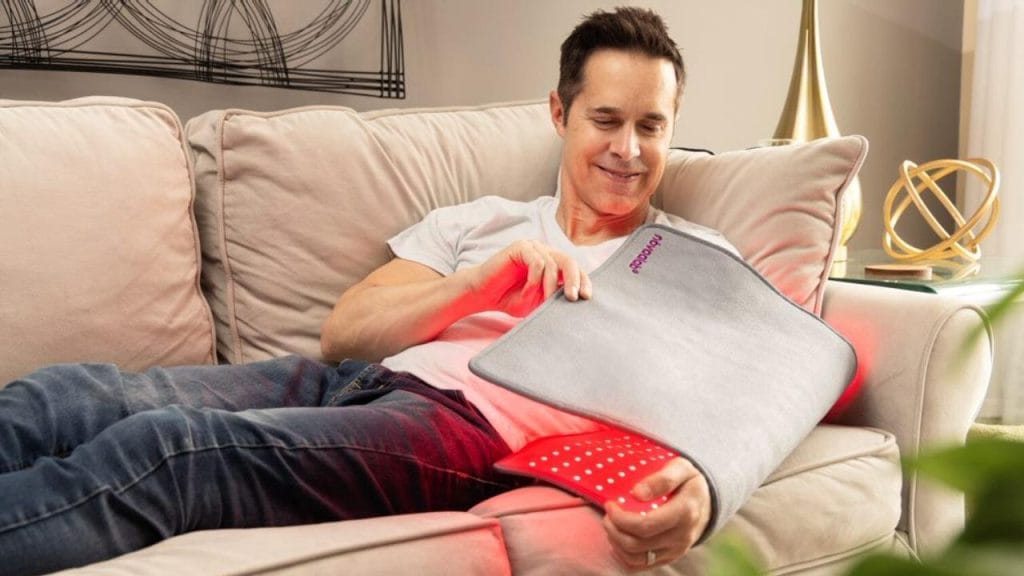Red Light Therapy for Nerve Pain Management: Here’s How It Works
We include links to products we think are useful for our readers. If you click and buy a product through one of the affiliate links on this page, we may earn a small commission.

Red light therapy is gaining attention as a promising treatment for nerve pain, a condition that affects many people worldwide. This therapy uses specific wavelengths of light to penetrate the skin and tissues, aiming to reduce pain and improve healing.
In this article, we will explore how red light therapy works, its benefits, and scientific backing. Additionally, we will provide practical advice on using red light therapy effectively at home and discuss its accessibility and cost.
Whether you are a long-time sufferer of nerve pain or looking for alternative treatments, this discussion aims to provide valuable insights into how red light therapy might offer relief.
Quick Key Takeaways
Effectiveness in Pain Reduction: RLT has been shown to significantly reduce nerve pain by stimulating cellular function and increasing energy production within cells, which can accelerate healing and reduce inflammation.
Safety and Minimal Side Effects: RLT is a safe, non-invasive treatment option that typically results in few to no side effects, making it a viable alternative to more invasive procedures or pharmaceutical treatments that can have more severe side effects.
Ease of Use and Accessibility: With the availability of portable and home-use devices, RLT offers a convenient treatment option that can be done at home, reducing the need for frequent visits to healthcare providers and allowing for regular application.
Financial Considerations: Although red light therapy devices offer a non-invasive solution to nerve pain, they typically require a direct purchase since most insurance plans do not cover them. Costs range significantly based on the type and quality of the device, necessitating an upfront investment. However, the long-term benefits and potential savings on traditional medical treatments may justify the initial expense for many users.
Scientific Support and Growing Popularity: Increasing scientific research supports the use of RLT in managing chronic pain conditions including nerve pain. This growing body of evidence, along with positive patient testimonials, is helping to increase its popularity and acceptance as a treatment option.
Understanding Nerve Pain or Neuropathic Pain

Nerve pain, or neuropathic pain, affects a significant portion of the population, manifesting as a persistent and often debilitating condition that can severely impact quality of life. In the United States, about 10% of adults experience nerve pain, with varying degrees of severity (The Good Body, 2023). This type of pain arises when nerve fibers themselves are damaged, dysfunctional, or injured, causing them to send incorrect signals to pain centers.
The prevalence of nerve pain increases with age and is more commonly reported among middle-aged and older adults. For instance, the prevalence of chronic pain, which often includes nerve pain, is notably higher in individuals aged 65 and above. Studies show that 30% of adults between 65 and 84 years suffer from chronic pain, a figure that rises to 34.3% in those older than 85 (The Good Body, 2023).
Ethnicity also plays a role in the prevalence of nerve pain, with some studies finding that middle-aged Hispanic populations report higher levels of neuropathic pain compared to non-Hispanic whites (DiBonaventura et al., 2017). Furthermore, the condition is more prevalent in individuals with other chronic conditions such as diabetes, which can lead to specific types of nerve pain like diabetic neuropathy.
The impact of nerve pain extends beyond physical symptoms; it is associated with significant psychological distress and a decreased ability to perform daily activities. High-impact chronic pain, which significantly interferes with day-to-day functions, affects approximately 6.9% of the U.S. population.
Efforts to manage and treat nerve pain can be complex, requiring a combination of medication, lifestyle adjustments, and, in some cases, therapies like red light therapy, which will be explored further in this article.
Red Light Therapy for Nerve Pain Treatment
Red light therapy (RLT), also known as photobiomodulation, involves exposing the body to low levels of red or near-infrared light. In this treatment, devices equipped with LEDs or lasers emit light that penetrates the skin to reach the underlying tissues. This type of light is believed to trigger biological processes that can help cells regenerate and repair themselves.
The concept of using light as a therapeutic tool is not new—it has been utilized in various forms for decades. However, advancements in technology have improved the efficacy and accessibility of these treatments, particularly for home use. Red light therapy devices now range from handheld units to full-body panels.
This therapy works at a cellular level. Mitochondria absorb the red light wavelengths, the power generators within cells, stimulating them to produce more adenosine triphosphate (ATP), the energy currency of the cell. This process promotes cell repair and can reduce inflammation and pain.
Red light therapy has been studied for various conditions, including:
Its role in nerve pain management, however, is of particular interest due to its non-invasive nature and lack of side effects typically associated with conventional pain medications.
Given its potential benefits, red light therapy is being adopted more widely both in clinical settings and at home. Its ease of use and the ability to treat pain without pharmacological interventions make it an appealing option for those suffering from chronic nerve pain. As research continues, the understanding and applications of red light therapy are likely to expand, offering new hope for pain relief.
Scientific Basis of Red Light Therapy for Nerve Pain
Recent research supports the efficacy of RLT in managing nerve pain. Data from Novaalab’s first quarter of 2024 survey highlights this point convincingly. Out of 205 participants who used RLT to treat nerve pain, 80% expressed satisfaction with its effectiveness.
Notably, these participants reported significant changes in pain levels: before the treatment, 35% had severe pain levels, which decreased to less than 5% post-treatment.
The majority of participants (59%) initially had mild to moderate pain levels, with only 24% reporting moderate levels after using the therapy.
The usage pattern among the participants also sheds light on the treatment’s practical application. On average, participants used the RLT devices 5.1 times per week over 3.7 weeks. This regular use is correlated with noticeable improvements, as 91% of participants reported enhancements in their overall conditions following the use of Novaalab products.
These findings underscore the potential of RLT as a valuable treatment option for nerve pain, particularly when used consistently and as part of a comprehensive pain management strategy. The reduction in pain severity and the high satisfaction rates among users highlight RLT’s role as an effective, non-invasive alternative to traditional pain relief methods.
Benefits of Red Light Therapy in Treating Nerve Pain
Red light therapy (RLT) offers several benefits for individuals suffering from nerve pain, making it an increasingly popular treatment option.
Here are some key advantages of using RLT:
Pain Reduction: RLT has been shown to significantly reduce pain levels in various conditions, including chronic neuropathic pain. The therapy’s ability to decrease inflammation and enhance blood circulation helps in alleviating pain and discomfort.
Improved Healing: The stimulation of mitochondria and increased ATP production not only helps in pain management but also enhances the body’s natural healing processes. This can be particularly beneficial for nerve repair and regeneration.
Non-Invasive Treatment: Unlike many medical treatments for nerve pain, RLT is non-invasive and can be administered without the need for surgical interventions or pharmaceuticals. This aspect makes it a safe option for many patients, especially those who are looking for alternatives to traditional pain medications.
Minimal Side Effects: One of the major benefits of RLT is its minimal side effect profile. Unlike opioid medications, which can cause a range of side effects including dependency, RLT does not pose such risks. Most users experience no adverse effects, making it a safer choice for long-term use.
Ease of Use and Convenience: With the availability of home-use RLT devices, patients can treat their nerve pain in the comfort of their own homes. This convenience allows for regular treatments, enhancing the therapy’s effectiveness.
How to Use Red Light Therapy for Nerve Pain

Using red light therapy (RLT) for nerve pain effectively requires understanding the proper techniques and guidelines to maximize benefits while ensuring safety.
Here’s how to use RLT:
Select the Right Device: Choose an FDA-approved RLT device that emits light at the correct wavelengths, typically between 600 to 1000 nm. Devices come in various forms, including handheld units, panels, and beds.
Duration and Frequency: Treatment duration and frequency can vary depending on the device and the severity of the pain. Generally, sessions last between 10 to 20 minutes and are recommended 3 to 5 times a week. Follow the manufacturer’s guidelines or consult with a healthcare professional.
Direct Application: Apply the light directly to the area of nerve pain, ensuring that the skin is clean and free of clothing or obstructions. The light should be close to the skin but not uncomfortably hot.
Safety Precautions: Avoid looking directly into the light to protect your eyes, even if the device does not emit UV radiation. Use safety glasses if recommended.
Monitor Your Response: Keep track of your pain levels and any side effects. Adjust the frequency or duration of sessions based on your response.
Frequently Asked Questions about Red Light Therapy for Nerve Pain
Red light therapy uses low-level red wavelengths of light to treat various conditions by promoting healing and reducing inflammation.
RLT helps reduce nerve pain by stimulating cells to produce more energy, enhancing healing, and reducing inflammation which can alleviate pain.
Yes, red light therapy is generally safe. It is a non-invasive treatment with minimal side effects, primarily used for improving skin health, reducing inflammation, and alleviating pain.
Treatment frequency can vary, but most guidelines suggest using RLT three to five times per week, with each session lasting about 10 to 20 minutes, depending on the device and the severity of pain.
Yes, there are many FDA-approved devices available for home use. These range from handheld units to larger panels, allowing flexible treatment options in the comfort of your own home.
Red light therapy is known for having very few side effects. The most common are slight irritation and redness of the skin immediately after treatment, which typically subsides quickly.
Results can vary; some people may notice improvements in pain and inflammation within a few weeks, while for others, it might take longer. Consistent treatment is key to achieving beneficial outcomes.
Conclusion
Red light therapy (RLT) presents a promising option for those suffering from nerve pain, offering benefits like pain reduction, improved healing, and minimal side effects. This therapy provides a non-invasive, safe alternative to traditional pain medications and can be used conveniently at home. While the initial cost of devices may be high, the potential for long-term relief and improved quality of life can justify the investment.
As always, individuals should consult with healthcare providers before starting new treatments to ensure it is appropriate for their specific health needs. With ongoing research, the future of RLT in pain management looks bright.
References
Barker, P. A., Mantyh, P., Arendt-Nielsen, L., Viktrup, L., & Tive, L. (2020). Nerve growth factor signaling and its contribution to pain. Journal of pain research, 1223-1241.
DiBonaventura, M. D., Sadosky, A., Concialdi, K., Hopps, M., Kudel, I., Parsons, B., Cappelleri, J. C., Hlavacek, P., Alexander, A. H., Stacey, B. R., Markman, J. D., & Farrar, J. T. (Year). The prevalence of probable neuropathic pain in the US: results from a multicenter survey. Journal of Pain Research, volume(issue), pages.

